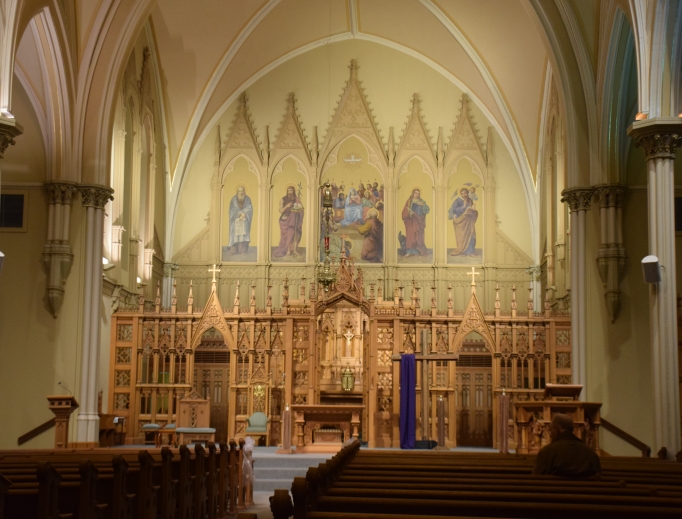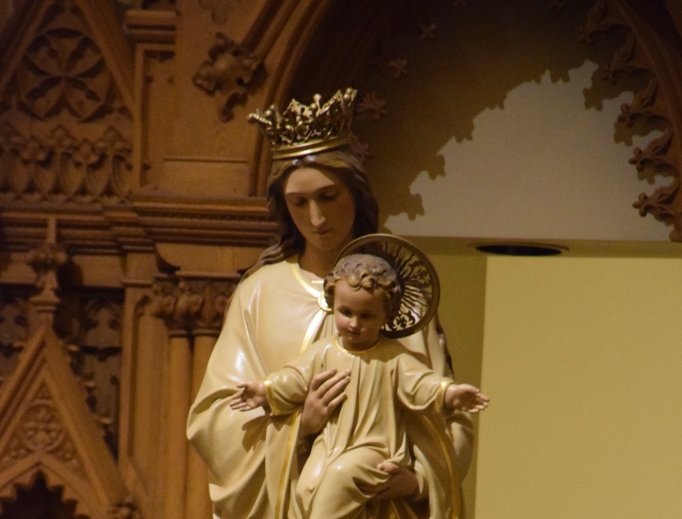Celebrating the Archangels — in Iowa
The Cathedral of St. Raphael has a storied history along the Mississippi River.

Outside the Cathedral of St. Raphael in Dubuque, Iowa, is a small park named Cathedral Square. At its center is a sculpture of several figures: a priest, a miner, a riverboat captain and a farming couple. According to the artist, each figure represents the progression of settlers who came to call this area of Iowa home more than 175 years ago.
First came the priest — and he was not just any priest. The foundation for this Catholic community was laid by a missionary Dominican friar whose cause is up for sainthood. Venerable Samuel Charles Mazzuchelli was an Italian Dominican who came to the U.S. as a deacon in 1828. After his priestly ordination two years later, he first served at a mission on Mackinac Island, a part of what would eventually become Michigan, and spent much of his priesthood spreading the faith in the state of Illinois and in territory that less than two decades after his ordination became the states of Wisconsin (1848) and Iowa (1846).
In the summer of 1835 Father Mazzuchelli, a self-taught architect, broke ground for a stone church to be built in Dubuque. The church was dedicated to St. Raphael and became a cathedral several years later, with the appointment of Dubuque’s first bishop, Bishop Mathias Loras, a native of France (and a seminary classmate of St. John Vianney).
The local Catholic community soon outgrew this first structure, and the foundation for the current church building was laid in 1857. The first Mass in the church was celebrated that Christmas. Bishop Loras died just two months later, in February 1858, and, unfortunately, did not see the cathedral in its finished glory. For more than a century, the Sisters of Charity staffed a school on the cathedral grounds. It closed in 1976.
In the 1980s, the cathedral saw major renovations and updates. These included the carpeting of the church, the creation of a gathering space known as the Cathedral Center and the restoration and cleaning of statues and artwork. The work was completed in 1986. In 2010, nearby St. Patrick Catholic Church was linked to St. Raphael’s as to better serve the changing demographics and needs of both parishes. Today, the merged parishes are served by one priest.
Carved in Wood
Upon entering, visitors are greeted by magnificent wooden decor. From the sanctuary and altar to the pews in the back, a light oak finish colors the furniture. According to the cathedral’s website, this wasn’t always the case. During the church’s renovation all of the interior woodwork was refinished, replacing a thick, dark stain.


The cathedral’s Stations of the Cross highlight this fine wood work best. These 14 depictions of Christ’s last steps that line her walls are large, wooden reliefs from Munich that were brought to the Hawkeye State in the 1890s.
Equally impressive is an ornate wooden screen or divider that was erected in the sanctuary during the renovations of the 1980s. Crowned with carved crosses and intricate designs, the divider created a small prayer space between the main altar and the original tabernacle. Today, this space serves as an adoration chapel with chairs and kneelers. Also in the sanctuary is an impressive wooden ambo. It contains the carved figures of Matthew, Mark, Luke and John at its base.
Stained in Glass
The stained-glass windows, which were imported from England, serve as a who’s who in biblical and Church history. On one side of the church are windows depicting Old Testament patriarchs and leaders. There is Moses holding his staff along with David playing his harp and Aaron with a bowl and hyssop. Further down the wall, Queen Esther is seen appropriately with a crown and scepter. Next to her is the heroine Judith holding a sword in one hand and the head of Holofernes in the other.
On the opposite wall of the cathedral, light shines through a series of stained-glass windows portraying images of the saints. There is St. Francis Xavier seen with a cross, Bible and rosary. Next to him is St. Charles Borromeo wearing a red cardinal cappello and holding a Bible and cross.
Interestingly, a number of Irish holy men and women are here, too, in honor of the church’s early Irish parishioners. They include Sts. Lawrence O’Toole, Bridget and Modwenna. Bridget holds a crosier, symbolizing her role of abbess of her convent. Modwenna is seen with a dragon at her feet. She is the patron saint of Burton Abbey in England.
Holy History
While Bishop Loras died before the cathedral’s construction was completed, his legacy has been kept alive. In the back of the church, hanging on the wall, is a shadowbox that displays an original stole of his. Other historic church vessels and vestments are on display, as well.
Also in the entrance is, fittingly, a large painting of the cathedral’s patron, St. Raphael the Archangel. It captures the colorful story of the church’s patron, along with Tobit and Tobias.
Below it is an original church bench or sedilia, complete with hand-carved decorations at its base and handles. A sign nearby states it sat in the cathedral’s sanctuary for decades.
A particularly interesting story is that of the box that sits below the main altar, containing the remains of St. Cessianus, an 8-year-old who was martyred during the reign of Roman Emperor Diocletian at around the turn of the fourth century. The reliquary was presented personally to Bishop Loras by Pope Gregory XI before Bishop Loras came to the United States in the 1830s. In 1986, as part of the completion of the cathedral’s remodel, the holy remains were boxed and installed in the main altar.
With its tall steeple and loud bells, St. Raphael’s, in her early days, must have been a welcomed sight and sound to riverboat traffic and train travelers arriving in Dubuque. They would have spotted the church or heard the beckoning peal.
According to a brochure found in the back of the church, this community, which is the oldest parish in Iowa, still plays a strong role in ministering to the downtown population. Over the past decade, it has become all the more strengthened with is connection to nearby St. Patrick parish. The combined parishes serve as a beacon of hope and hospitality to those in need in the city of Dubuque — just as they long have at St. Raphael’s, located just a few blocks away from the banks of the Mighty Mississippi.
Register correspondent Eddie O’Neill writes from Houghton, Michigan

















